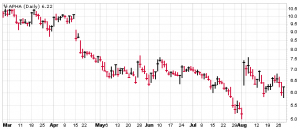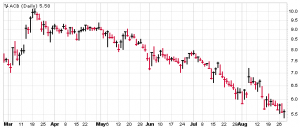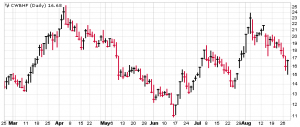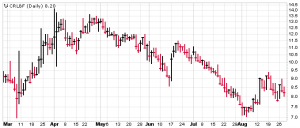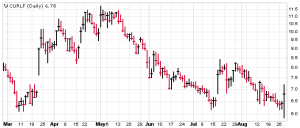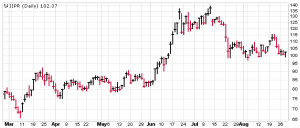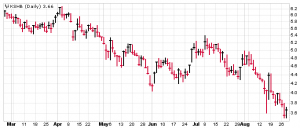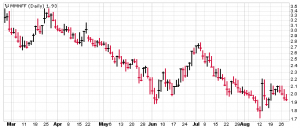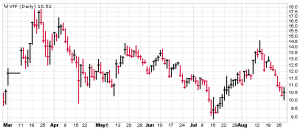The cannabis sector remains in a correction, but many of our stocks are doing considerably better than the sector. And the sector itself is very likely near a bottom—which I why today’s issue is titled “Buying Opportunity.”
For new investors, it’s a great time to get started.
However, I’m also recommending reducing positions in four of our holdings, always working to put more of our money in the leading stocks—and with these sales, our cash level will rise—hopefully briefly—to 30%.
Cabot Marijuana Investor 819
Buying Opportunity
It’s been rather frustrating to see cannabis stocks falling day after day, week after week, while the companies’ quarterly reports (with the exception of Canopy Growth) continue to reveal that business is booming. But that’s how the market works.
First, cannabis stocks attracted a slew of new investors with an early-year boom that saw the sector gain 50% in four months—bringing in the most investors right at the top. And then, as first the cannabis sector and then the broad market rolled over, it gradually persuaded those investors to sell, at a loss, at increasingly lower prices. But somewhere, just as if it seems this downtrend will never end, and you really should give up and put all your money in T-bills (which yield basically nothing!), the sellers will be done and the buyers will take control again, sending the stocks on a renewed uptrend.
Marijuana Index
In fact, it’s quite possible that yesterday was the bottom for the sector. And for those of our stocks that bottomed earlier—say, back in July—the lows of this week look like a fine buying opportunity. You’ll find some buying recommendations in the individual stock updates. But first, a few news items.
News
Today, both Ontario and Quebec—Canada’s two most populous provinces—have one marijuana store for every 595,000 and 495,000 people, respectively, while in Colorado, there’s one store for every 10,000 people. In Colorado, that might be too many stores, but in Canada there’s definitely a need for many, many more. Also in Canada, edibles and vapes will become legal on October 17, one year after flower became legal, and products will hit the shelves two months later. Experts are predicting shortages, echoing the shortages of flower in the first year, but overall, it will be one more step on the long path to growth.
Meanwhile, in the U.S., the march toward nationwide legalization continues, with encouraging news from Minnesota, Ohio, and Alaska. And in the 36 states where medical marijuana is available, the fastest growth is coming from Oklahoma, Florida, Ohio and Illinois (all states where adult-use is still illegal).
Investing Strategy
Our strategy is twofold.
One, we want to own the stocks that are likely to be the leaders of this industry five and 10 years from now, because long-term investing is where the big money is made. Two, we want to make money in the short term, by overweighting our investments in strong stocks and underweighting our investments in stocks that are weak—and holding cash when appropriate.
Sometimes this means selling at peaks and taking short-term profits—which can be fun. And sometimes it means selling and taking short-term losses—which is never fun. But one of the cardinal rules of growth stock investing is that you must cut losses short, so that you can have cash to redeploy into stronger stocks. A corollary of this is that we never average down; instead we average up, rewarding success.
Additionally, diversification is mandatory. Any one stock can go wrong; but if you invest in enough of these cannabis stocks, the long-term trend of the industry is guaranteed to reward you. Recently, for example, Canadian marijuana stocks have been generally weak, both because they were strongest earlier this year and because Canopy Growth’s results put a damper on the sector. But U.S. marijuana stocks and CBD stocks have held up better, as money sloshes around in the sector, positioning for the next big uptrend.
Lastly, a note to our newer readers. You’ve arrived at what is probably a great time to invest in the industry—but don’t be in a hurry to jump in. Study the charts, understand what you’re buying, and take it slow, working to build a diversified portfolio over time.
WHAT TO DO NOW
Going into today, the portfolio is 20% in cash, 80% invested, and most heavily invested in Aphria (APHA) and Curaleaf (CURLF), the current largest revenue producers in Canada and the U.S. I hope to use our cash to do some new buying soon, both in current holdings and new additions, but I need to see a little more sector strength first. In the meantime, I’m paring back more on some of our weakest stocks, selling half of Aurora (ACB), half of Innovative Industrial Properties (IIPR), all of KushCo (KSHB) and taking our position in Canopy Growth (CGC) down to 1%. After these actions, the portfolio will be about 31% in cash, but hopefully not for long.
CURRENT RECOMMENDATIONS
Alcanna (LQSIF)
The portfolio’s most recent addition, Alcanna is a big Canadian alcohol retailer that’s diversifying into the cannabis retailing business. Second-quarter results, reported August 9, saw revenues grow 20% from the year before to $200 million (making this the top revenue generator in the portfolio), but a profit of five cents a share fell to a loss of 15 cents per share—the result of the cannabis investments. At quarter’s end, the company was operating nine cannabis stores—with its store on Queen Street, Toronto averaging $450,000 per week, the highest volume store of all the company’s 261 locations (most of which are alcohol). Looking forward, the company’s goal is to open 15 to 20 additional retail cannabis locations in Alberta by the end of 2019. Thus, the prospects are good and the stock is very cheap, selling at just 0.2 times revenues. But investors have been selling since the report was released, and as I write, the stock is back where it bottomed in May. The portfolio averaged up two weeks ago, but because of its weak performance I will now downgrade LQSIF to Hold.
Aphria (APHA)
APHA is the cheapest of the big Canadian cannabis stocks, thanks in part to some management missteps last year, and it’s also the biggest, having wrested the crown from Canopy in the second quarter by selling $129 million of marijuana and related products. And it’s also got one of the best charts—though that’s not saying much in this sector. Since gapping up on big volume on August 2 after its excellent earnings report, the stock has drifted slowly lower, but remains well above its August 1 low of 5. Fundamentally, analysts are projecting earnings of $0.12 per share in 2010 and $0.23 in 2021, which sounds good to me. The portfolio averaged up two weeks ago, and this is now our largest position. If you’re going to buy one Canadian marijuana stock today, this is the one. Buy.
Aurora Cannabis (ACB)
Aurora is not only more expensive than APHA on a PSR basis, its stock is also significantly weaker—perhaps because analysts don’t expect earnings until 2021. After gapping up after its earnings report on August 6, the stock fell right back down to its old lows and is now plumbing depths unseen since January. The portfolio averaged up two weeks ago, but that proved overly optimistic and now I will reduce the portfolio’s position by half. Sell Half.
Canopy Growth (CGC)
Canopy has lost the crown, so now we have more insight into why CEO Bruce Linton was fired. Not only did Canopy fail to sell as much cannabis as Aphria did in the second quarter, Canopy couldn’t even sell as much cannabis as Canopy did in the first quarter! Inventories grew, but revenues actually fell 13% from the first quarter. Admittedly, that was up 251% from the year before, but the short-term trend is troubling. And I’m not the only one troubled; the stock has now fallen below its low of last December—and analysts don’t expect earnings until fiscal 2022 (which begins April 2021). The portfolio has been underweight CGC for a long time due to valuation concerns, and now we will sell even more, taking our position down to just 1%. Sell Most.
Charlotte’s Web (CWBHF)
Colorado-based Charlotte’s Web is America’s biggest seller of CBD, with more than 8,000 retail locations supplied by hemp grown on 862 acres. Revenues in the second quarter grew to $25 million, up 45% from the year before. Earnings per share were $0.02, just as in the previous three quarters. And going forward, analysts are projecting earnings per share of $0.19 this year and $0.69 next year, so all looks good. But the stock is not cheap, selling at 84 times forward earnings—and like all these stocks, it can have big swings. The portfolio sold half its position in CWBHF on August 5, the last day of a very strong eight-day advance, because I judged it to be near a short-term peak, and since then the stock has been cooling off. It just bounced off its 200-day moving average yesterday, and it’s tempting to get back in here, but I’m going to give it a little more time. Hold.
Cresco Labs (CRLBF)
The third-largest multi-state operator (MSO) in the U.S., Cresco released its second-quarter report on August 21. Revenues were $29.9 million, up 253% from the year before and up 42% from the previous quarter. Losses persist. But analysts are looking for a profit of $0.34 per share in 2020. The company is currently operational in seven U.S. states, has transactions pending in New York, Massachusetts and Florida, and expects its acquisition of Origin House, which will greatly expand its distribution network in California, to close during the fourth quarter of 2019. Meanwhile, Cresco is rolling out its Sunnyside dispensaries nationwide, while expanding into the CBD market with the launch of a WellBeings product line. As for the stock, it’s done well this month, surging from a bottom at 7 to a short-term peak at 9 and now settling back to the middle of that zone, where I expect— if all goes well—buyers will give it support. The portfolio averaged up two weeks ago and will hold, but if you don’t own it, you could buy here. Buy.
Cronos Group (CRON)
Poor Cronos. By all rights, the company should be a major player in the Canadian cannabis market; after all, that’s why Altria paid $1.8 billion for 45% of the company. But second-quarter revenues were only $10.2 million (up 202% from the year before), and while analysts see a profit of $0.90 this year, they see losses again in 2020. Worst of all, CRON remains the most egregiously overvalued of all these stocks, valued at $3.8 billion. And the chart keeps trending down. The portfolio sold half its position last October, half the remainder in January, half the remainder in April and half the remainder just two weeks ago, so is now severely underweighted. Yes, I could sell it all and be totally out of the stock, but I can’t give up on the promise that Altria will lend real expertise to the company—and Cronos does have $2.3 billion in cash to play with. Hold.
Curaleaf Holdings (CURLF)
Management at Curaleaf says the company is on track to be the biggest MOS in the U.S.—and the market is starting to believe them! Second-quarter results, released after the market close Wednesday, revealed these highlights: revenue of $55.1 million was up 219% from the year before and 35% over the prior quarter. Pro forma revenue (counting pending acquisitions) was $110.9 million. And in 2020, management is looking for revenue of $1 billion to $1.2 billion! Key to that eye-popping growth will be the smooth integration of the acquisitions of Select, the leading cannabis wholesale brand in the U.S., and Grassroots, the largest private U.S. MSO. When those are complete, Curaleaf will be in 19 states, with a strong presence on both the east and west coasts. In fact, analysts are projecting EPS of $0.08 this year and $0.30 in 2020. The market loved the report, sending the stock up as much as 13% yesterday before closing up 6%. The portfolio took profits in May, selling half at 9.05, and bought back in two weeks ago at 7 to become overweighted again, so will now stand pat, but if you don’t own any, you could buy here. Buy.
Innovative Industrial Properties (IIPR)
The only publicly traded REIT focused on the cannabis industry, IIPR has been a big winner for us, but since mid-July the stock has been cooling off, and now I’m beginning to think its best days are over, mainly because, while REITs in general have been doing well in this safety-conscious market, IIPR has done nothing for the past five weeks—and the stock’s valuation is still sky-high at 34 times revenues. Fundamentally, growth is still very much in the cards here, with analysts projecting 2019 EPS of $2.79 and 2020 EPS of $4.60. But the stock seems to have discounted all that. The portfolio sold a third of its position in June at 133, when the stock’s rise seemed unsustainable, and since then the stock has come down to build a base at 100, which it is at risk of tumbling off of any day. One way to play this might be with a stop, but I’ll keep it simple. The portfolio will now lighten up again, taking profits on half the remaining position. Sell Half.
KushCo Holdings (KSHB)
A supplier of containers and processing gases to the industry, KushCo is still growing at a good speed, with second-quarter revenues up 221% from the year before. However, operations are still in the red, and now, after 19 months of trading in a range between 4 and 7, KSHB has fallen well below 4, dimming hopes that it will resume its uptrend. The portfolio last took profits by selling half in June at 4.4, and will now sell the remainder, exiting the position entirely. Early on, this stock contributed greatly to the portfolio’s diversification, but it’s time to move on. Sell.
MedMen (MMNFF)
MedMen, one of the leading MSOs in the U.S, announced preliminary fourth-quarter results August 13, and the market liked what it saw. Pro forma revenue, which includes pending acquisitions that have not yet closed, totaled $61.3 million, up 196% from the year before. Red ink still flows, and will continue to do so next year, but as the company’s reach expands—the acquisitions will result in a total of 92 retail stores across the U.S., including 17 retail stores in California—economies of scale will kick in. In fact, the company is already on track to achieve an approximately 30% overall reduction in corporate SG&A from the December 2018 quarter, surpassing its initial target reduction of 20%.
Other highlights: The company’s 11 operational retail locations in California reported a combined $27.4 million in revenue for the fourth quarter, an increase of 10% sequentially. In Illinois, where adult cannabis use is expected to be legal beginning January 1, MedMen expects to have 10 store locations. And in Florida, MedMen is licensed to open up to 35 retail locations and has over 20 leases already secured. Also, MedMen is now beginning to offer same-day delivery across California – a legalized cannabis market that could potentially generate $11 billion in annual sales. After the report, MMNFF surged as much as 23% on big volume, and while it’s given up some of that gain since then, the chart (optimistically) is now showing a reverse head-and-shoulders pattern that could presage a new advance. The portfolio is still under water in the stock, so can’t average down, but if you don’t own it, you could buy here. Buy.
Organigram (OGI)
OrganiGram is one of our weakest stocks, yet the company is growing fast and the fundamentals say long-term prospects are good for this second-tier Canadian company; Cronos could even buy it! Third fiscal-quarter results saw revenues up 747% from the year before to $24.8 million, and analysts are projecting EPS of $0.16 in 2020. Valuation is roughly middle-of the pack, but until the stock shows some strength, it’s only attractive as a hold for investors who got in early. Hold.
Turning Point Brands (TPB)
Turning Point Brands is the old-school smokeless tobacco company that’s been transitioning into the cannabis business successfully. Second-quarter revenues grew 15% to $94.3 million, analysts are looking for EPS of $2.06 this year and $2.54 next year, and the company pays a dividend of 0.5%. The stock has been a great source of diversification and stability for this portfolio, and having pulled back 40% from its July high, seems ready to resume its long-term uptrend. If you don’t own it and you like the story, you could nibble here. Buy.
Village Farms International (VFF)
Village Farms International is the Canadian greenhouse grower of tomatoes, cucumbers and peppers that’s diversifying into marijuana (in Canada) and hemp (in the U.S.). The company saw revenues of $41.3 million in the second quarter, down 2% from the year before, and EPS of $0.20. For the full year, analysts are expecting $0.68 and for 2020, $0.81—and on that basis, the forward P/E is just 15. The stock has pulled back substantially over the past three weeks but remains well above its July low. If you haven’t bought yet, you can buy here. Buy.
THE NEXT CABOT MARIJUANA INVESTOR WILL BE PUBLISHED September 26, 2019
Neither Cabot Wealth Network nor our employees are compensated by the companies we recommend. Sources of information are believed to be reliable, but are in no way guaranteed to be complete or without error. Recommendations, opinions or suggestions are given with the understanding that subscribers acting on the information assume all risks. © Cabot Wealth Network. Copying and/or electronic transmission of this report is a violation of U.S. copyright law. For the protection of our subscribers, if copyright laws are violated, the subscription will be terminated. To subscribe or for information on our privacy policy, call 978-745-5532, visit www.cabotwealth.com or write to support@cabotwealth.com.





